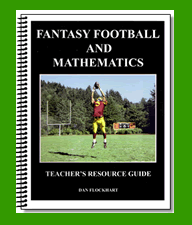Math & Fantasy Football
 Dan Flockhart is a Math teacher at College of
Dan Flockhart is a Math teacher at College ofthe Redwoods, in Eureka, California.
The author developed this book on 'Fantasy
Football and Mathematics" as part of a thesis
project for a Masters degree at Humboldt
State University by combining 20 years'
participation in Fantasy Football with 11
years experience teaching mathematics to
students in grades 5–8. The book can be
found at www.fantasyfootballmath.com
and lists for $19.95. Dan launched this
company in 2004.
The book can be used as a teacher’s
resource guide for grades 5-12. The
guide aims to motivate students and
close the achievement gap between white students and underrepresented
students by capitalizing on the phenomenal growth of Fantasy Football, a
game in which 30 million people worldwide participate. The book
illustrates fractions, linear equations, some geometry and more with
football statistics and various scenarios. The website that accompanies
the book has many examples and further explanation of the concept.

 Harvard University researchers Gary
Harvard University researchers Gary
